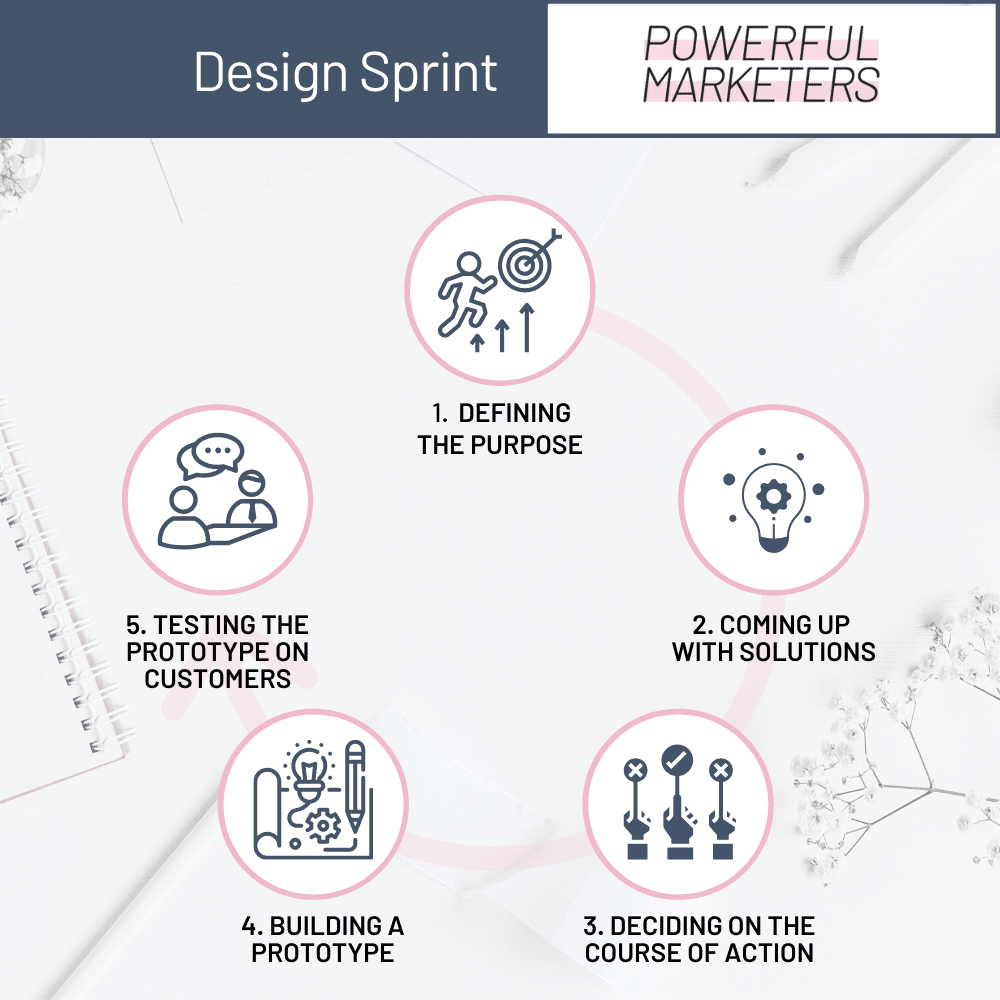There are not many businesses that have been left untouched by the effects of the pandemic. The new regulations, new patterns in consumer behavior, decrease in revenue and the overall uncertainty about the future are just a few challenges that business owners now face. However, every challenge always provides plenty of opportunities. The principle of ‘adapt or die’ remains true both in business and in nature.
Now is the time to really analyze what the biggest challenge for your business is, what your ideal reality would look like, and how you could get there by innovating your products, services or processes. The good news is that you don’t need years, tons of money and the best experts of the industry to innovate your business. You just need your core team, 5 distraction-free days and the powerful Design Sprint process. That is what we discussed on our latest Powerful Marketer Talks webinar “How to Innovate Your Business in 5 Days?” – find the full recording of the webinar at the end of the post!

Design Sprint method
Design Sprint is a method created by the Google designer Jake Knapp, and it makes any brainstorming and result development process ultrasonic, as it only takes 5 days. Make sure to involve your key team members, as design sprint is focused on team effort.
Ideally a design sprint requires the following roles:
- The decision maker: The company leader or someone with in-depth knowledge about the problem you’re solving;
- The financial expert: Someone who fully understands the costs and financial possibilities of the company;
- The marketing expert: Someone who knows how to make your product or solution reach the hands of the customer;
- The client expert: Someone who knows the clients and understands their challenges in depth;
- The logistics expert: A person who understands how to carry out all the steps necessary for the product or solution to be successful;
- The problems creator: Someone who has an antagonistic vision to the team, to bring new perspectives;
- The facilitator: A project manager who keeps the process running on time and makes agile decisions.
However, if your team does not have that many members, then you can still successfully carry out a design sprint. Just keep in mind the roles and assign different roles to one person.
Make sure that every participant has cleared their calendar for the 5-day period and ideally find a place or an environment where your team can work efficiently and creatively during this 5-day period, without having any distractions from their ‘regular work’. With lunch in-between, the Design Sprint days last for about 7-8 hours. So, make sure the lunch, snacks, coffee, stationary items, such as pens, markers, post-its etc, are all prepared, so you don’t need to worry about them as you go through the Design Sprint process each day.
The sprint starts Monday morning, and for Friday you should already have pre-scheduled video calls with the customers to introduce to them the prototype or the new idea for innovation. So, make sure that those are booked, as this will help keep you accountable.

MONDAY – DEFINE THE PURPOSE
On Monday morning, the first step is to ask the team what the main challenge is. Most likely, you will find out many, map the challenges and focus on the biggest priority. Make sure you take into account the necessary resources and external factors that may occur in resolving this challenge. Everybody should agree what is the priority challenge and what we are trying to resolve during the sprint. The next step is to picture the ideal situation, the goal you would like to achieve. Build the path backwards, towards where you are. Map out the potential pitfalls and problems that may occur and find out what might cause them.
TUESDAY – COME UP WITH SOLUTIONS
On Tuesday have each member write down on a separate paper or post-it, what the possible solutions to the agreed-upon challenge could be. Collect all the ideas and put them on a wall or a whiteboard. Give each team member 3 minutes to present their ideas. After which you should be able to collectively choose the 3 best ideas. Once that’s settled, participants should create sketches of potential solutions on the wall. By the end of Tuesday, you’ll have 3 possible paths you could take to achieve your goal.
WEDNESDAY – DECIDE ON THE COURSE OF ACTION
On the third day, the team needs to decide which is the path they are going to take. Which solution is the preferred one? Participants can vote for the idea they most believe in by adding colorful stickers or dots to the ideas presented on the wall. The idea that gets the most points wins. In case of a draw, the Decision Maker breaks the draw. After the winner is chosen, the team needs to draw a prototype on a whiteboard on how the best idea would work. The concept here is to draw out this prototype as if it were a movie or a comic book where the protagonist is the customer or the user, and each step that’s mapped out illustrates their interaction with the solution. Don’t focus on small details, but on the big challenges! The whole idea is that everybody involved can understand how the possible solution could work.
THURSDAY – BUILD A PROTOTYPE
Thursday is all about building and improving your prototype. Remember, it doesn’t need to be perfect. Excessive detailing is tiring; it slows down the learning process and leaves the whole team frustrated. However, it needs to seem realistic enough so that customers can comprehend the solution. Make sure you use real texts, find the right images, designs and so on. There are many prototyping softwares available, but if you are not used to working with them, then don’t waste your time on trying to learn the functionalities of these softwares. Make do with what you can do – so, draw on a paper, or print something out and glue the pieces together. It can be a physical prototype, or it can be a drawing or a presentation online.
FRIDAY – TEST THE PROTOTYPE ON CUSTOMERS
Friday is the time to interview at least 5 clients to see their reactions and hear their feedback. 5 people will expose about 80% of the problems. So, really, you don’t have to do dozens of interviews to get the necessary qualitative feedback. Ask for honesty and show openness to criticism, don’t emphasize that YOU created the prototype – otherwise they may feel like they can’t tell you the truth in fear of offending you. Ask questions like “How did you understand the content? What do you think happens when you click here…? And how would you assess this feature on a scale 0-10? Was it clear enough? Can you relate to the idea? How much would you pay for this solution?”
Have another team member take notes on what the clients bring out, write down positive and negative aspects on the whiteboard. analyze the results and evaluate whether the prototype is promising and deserves to be developed or not. If not, that’s also OK, you have just lost 5 days and not years of research. However, if the feedback is positive, it shows that you are on the right track!

Innovation does not have to be complex. Some of the most powerful innovations that have completely transformed our life have been the simplest innovations! So, approach Design Sprint not as another obligation, but as a way for you to pinpoint your opportunities. You need to take the time to brainstorm. You need to shake things up. Change your environment. Open up your mind. See the possibilities around you. Innovate your business!
For a more detailed overview of this important subject, watch the full webinar recording below!
#marketing #business #leadership #entrepreneur #entrepreneurship #marketers #innovation #rethink #values #company #designsprint #team #brainstorming #process #focus